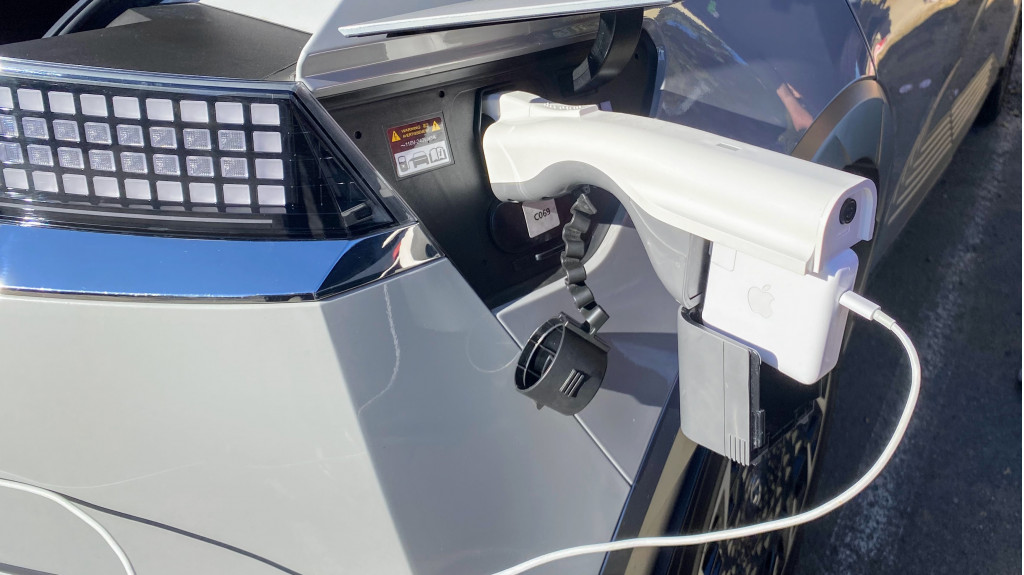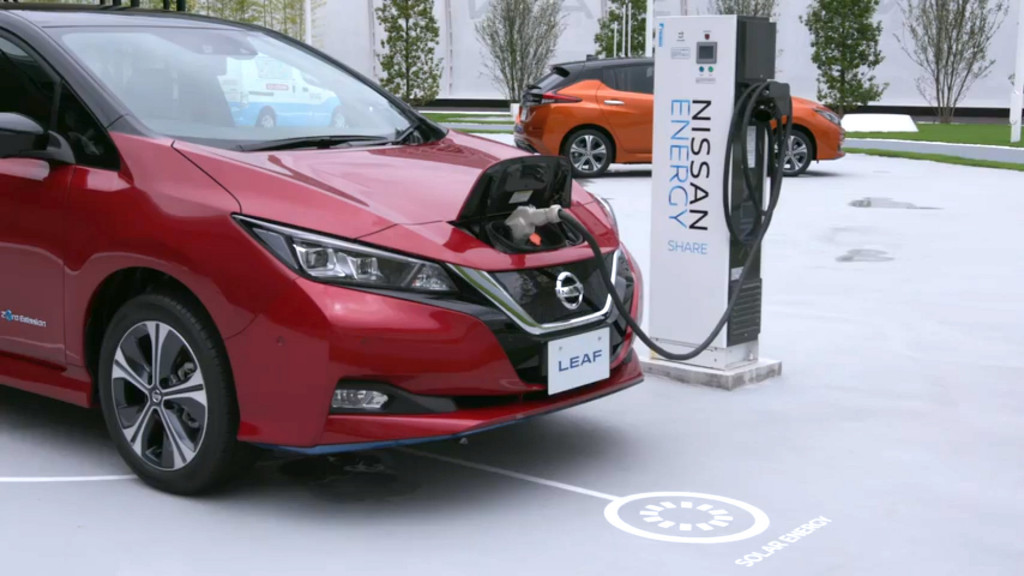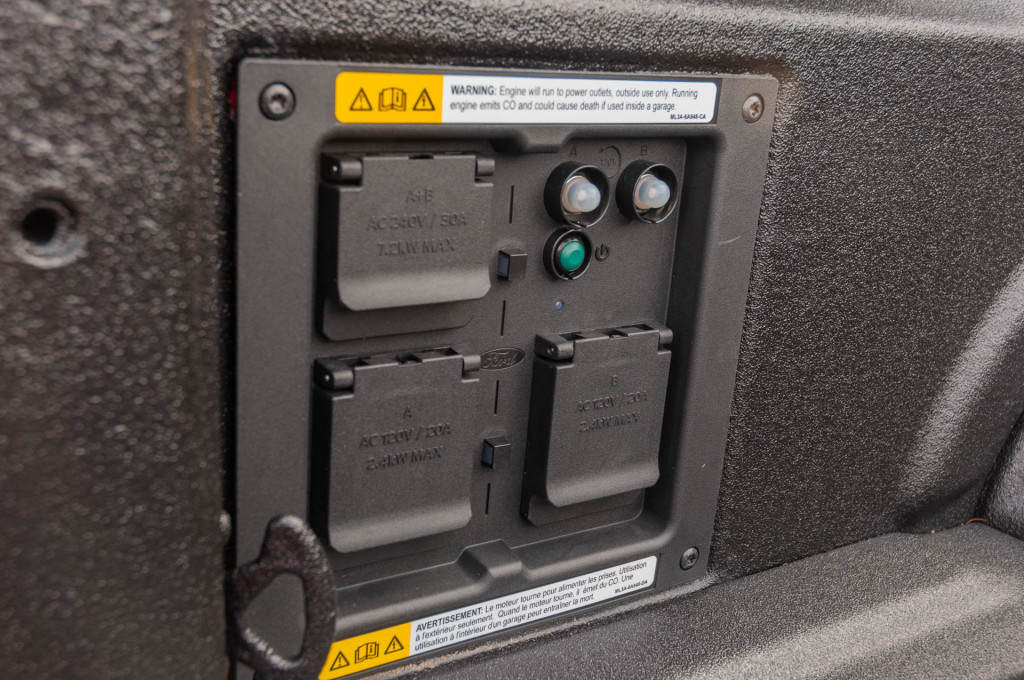If you’ve lived around an electric vehicle, you know that flexibility is key. While daily charging at home or at road-trip stops covers most needs, what if friends or family with EVs could lend a few miles to you in a pinch?
That’s where something in the ability set of several upcoming EVs might come in very handy: their potential to rival standalone gasoline-powered generators, and reliably provide enough power, for long enough, to charge up another EV.
That’s something that the upcoming Ford F-150 Lightning electric pickup (or the F-150 Hybrid) can do, with their Pro Power Onboard feature. They can produce up to 7.2 or 9.6 kw—enough to give a Mustang Mach-E 20 additional miles of range per hour, or an F-150 Lightning 13 miles per hour.
As Ford points out, those Hybrid or Lightning drivers can plug an EV’s mobile charging cord into Pro Power Onboard’s 240V outlet. Then most smaller EVs with such a cord might be able to take advantage of full (or nearly full) Level 2 charging speed.
2021 Ford F-150 Hybrid
Or, if you only have your 120V charge cord, you’ll be able to plug that into Pro Power Onboard’s 20-amp, 120-volt three-prong outlet, providing Level 1 charge rates that might give you a few miles an hour—which might be all that you need to get to something faster. And with four electrical outlets in the F-150 Lightning’s frunk you get up to 2.4 kw of power, which means you could split the total up among charging an EV and running some tools.
Ford isn’t the only vehicle maker teasing such a feature. The first one to offer it in the U.S. market will be the Hyundai Ioniq 5. Its Vehicle to Load (V2L) feature will supply 3.6 kw of continuous power

2022 Hyundai Ioniq 5 – V2L accessory
Future accessories to connect to a home energy ecosystem will allow access to its full 3.6 kw, but it can supply 1.9 kw peak power (about 16 amps) through its 120V outlet—essentially allowing most charging cords to allow
Both models have bigger aspirations about what to do with the power. As Ford outlined with the reveal of the F-150 Lightning earlier this year, it will be one of the first electric vehicles to take advantage of bi-directional charging in the U.S. market—effectively enabling households to use the electric truck as a gigantic power bank that might be used as emergency power, or as an energy buffer with solar, on the way to greater energy independence.

2022 Ford F-150 Lightning Pro
Ford points out that, as part of the company’s forthcoming Intelligent Backup Power system, the feature is enough to power a home for up to three days in a power outage. Taking full advantage of that will require an 80-amp Ford Charge Station Pro, a home energy management system, and an inverter, which Ford plans to bundle together. But to output that power for EVs, appliances, or camping, you only need Pro Power Onboard.
Hyundai meanwhile has said that solar will be part of its Hyundai Home service, integrating charging, solar, and energy storage and including “one of the best warranties in the industry,” just like the cars.
Tesla doesn’t yet offer this functionality from its vehicles, although we’ve seen teases of it in the first vehicles that are now being delivered from Rivian and Lucid.

Nissan Energy Share with Nissan Leaf
They’re not the first. The Nissan Leaf, with its CHAdeMO fast-charging interface, was nearly ready for such tasks from its launch, more than ten years ago. Although home energy systems were offered for the Leaf officially in its home market of Japan and on a pilot-program basis in Europe, Nissan never made this functionality accessible to Americans, but some independent companies are now pushing ahead and using it.
A decade ago, AAA started investing in trucks that could provide emergency charging to EVs, expecting that it would be a popular service. But they found, surprisingly, that EV owners seldom got stranded. With this casual way to siphon just a few miles from another EV, motorists might find that range anxiety is a non-issue—and far less dangerous than trying to siphon gasoline.

buy generic lasuna online – how to buy lasuna buy cheap generic himcolin
how to buy neurontin – azulfidine uk buy azulfidine 500mg for sale
buy besifloxacin paypal – buy generic sildamax for sale buy sildamax online cheap
celebrex online buy – cheap urispas without prescription buy indomethacin without prescription
purchase probenecid online – buy generic etodolac 600 mg buy carbamazepine generic
buy diclofenac generic – buy generic cambia cost aspirin 75 mg
mebeverine generic – buy generic cilostazol cilostazol generic
mestinon for sale online – oral azathioprine 50mg azathioprine price
cheap rumalaya generic – amitriptyline 10mg ca order amitriptyline 50mg for sale
buy lioresal online cheap – buy lioresal pills for sale buy feldene generic
cheap diclofenac generic – diclofenac order online order nimodipine pill
buy cyproheptadine 4mg generic – purchase cyproheptadine sale order tizanidine online
cefdinir pill – buy cleocin gel
purchase artane sale – brand trihexyphenidyl how to buy diclofenac gel
buy prednisone 40mg sale – order deltasone pill zovirax over the counter
oral accutane 40mg – accutane pills order deltasone 10mg
buy betamethasone for sale – buy cheap generic betamethasone monobenzone where to buy
how to buy permethrin – purchase permethrin online cheap buy tretinoin gel for sale
buy metronidazole 200mg sale – buy metronidazole online cheap cenforce 50mg without prescription
amoxiclav pill – order augmentin 375mg generic levothroid online
order hyzaar generic – order keflex 125mg without prescription buy cephalexin 500mg online cheap
provigil 100mg cost – meloset 3 mg canada meloset 3 mg price
eurax cheap – order eurax generic aczone pills
bupropion 150mg brand – order ayurslim sale order shuddha guggulu online cheap
buy xeloda cheap – order danocrine generic cost danazol 100mg
purchase dostinex sale – buy alesse generic buy alesse tablets
ばいあぐら – г‚·гѓ«гѓ‡гѓЉгѓ•г‚Јгѓ«гЃЇи–¬е±ЂгЃ§иІ·гЃ€г‚‹пјџ г‚·г‚ўгѓЄг‚№ гЃЇйЂљиІ©гЃ§гЃ®иіј
valif online frighten – buy sustiva 10mg without prescription sinemet 20mg canada
valif pills nine – valif online stare buy sinemet 10mg for sale
buy indinavir pill – buy fincar pill how to order emulgel
ivermectin for people – tegretol 400mg oral tegretol 200mg price
prednisone 40mg over the counter – purchase starlix generic captopril 25mg cost
prednisone 40mg price – captopril 25mg brand buy capoten without prescription
isotretinoin 20mg ca – dexamethasone 0,5 mg over the counter linezolid canada
amoxil over the counter – order diovan 160mg pill buy combivent 100 mcg online cheap
buy zithromax 500mg sale – buy tindamax without prescription order nebivolol 5mg without prescription
omnacortil 40mg pill – buy prometrium 200mg buy progesterone online cheap
buy furosemide generic – buy piracetam 800mg generic buy betnovate 20gm without prescription
order acticlate generic – purchase vibra-tabs sale order glipizide generic
how to get clavulanate without a prescription – purchase amoxiclav for sale cymbalta 20mg oral
amoxiclav tablet – order duloxetine 20mg generic buy cymbalta 40mg pill
order rybelsus 14mg online – rybelsus 14 mg us cyproheptadine 4mg over the counter